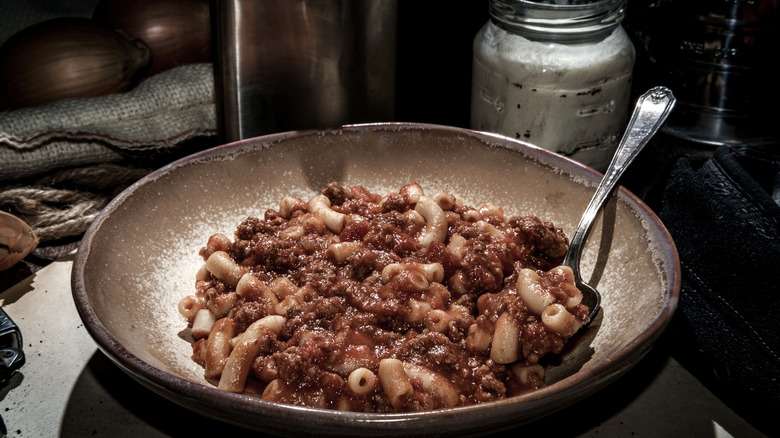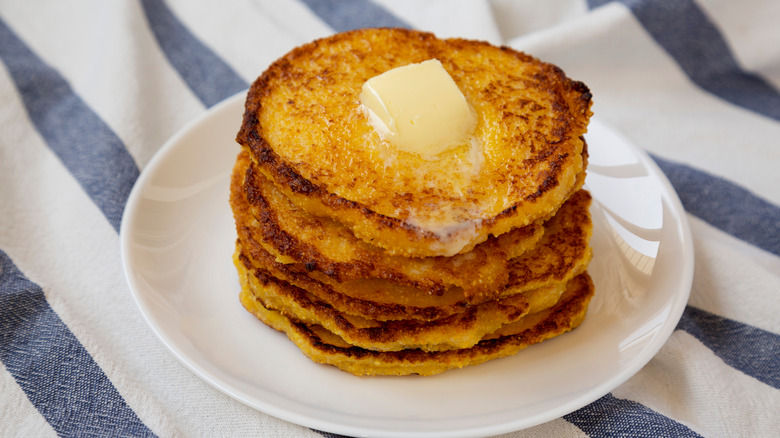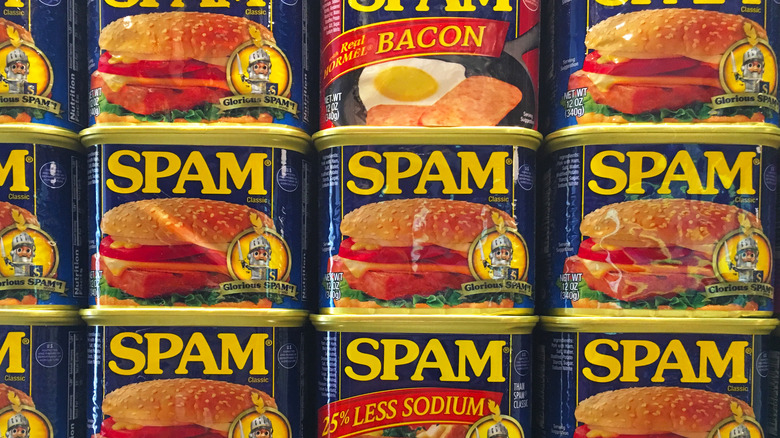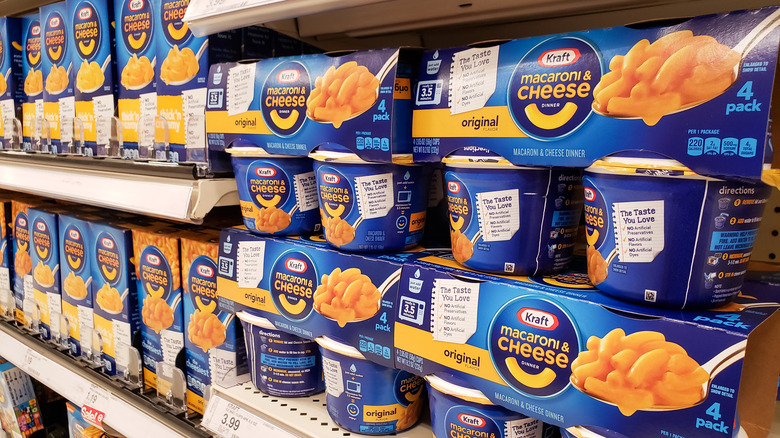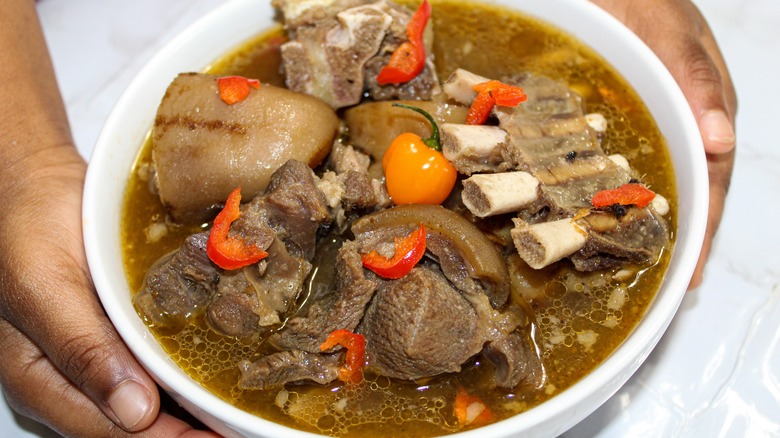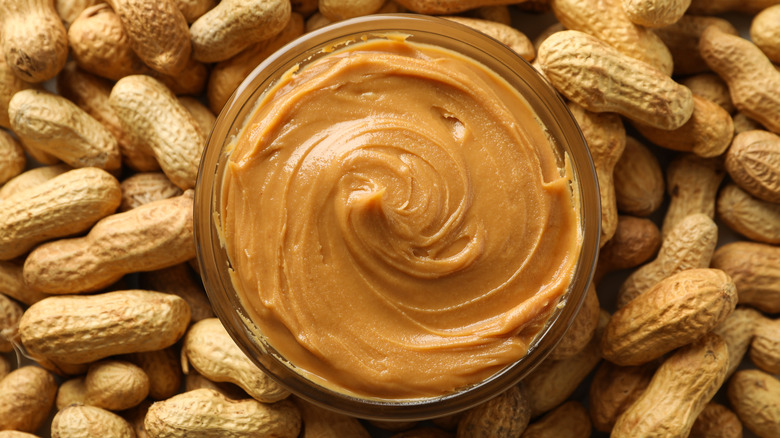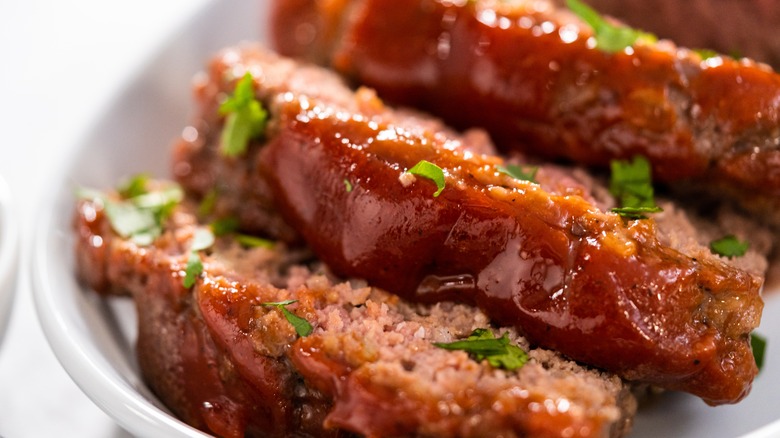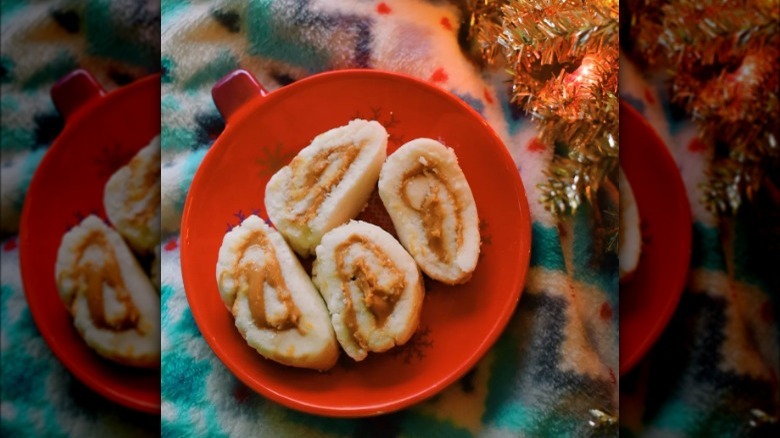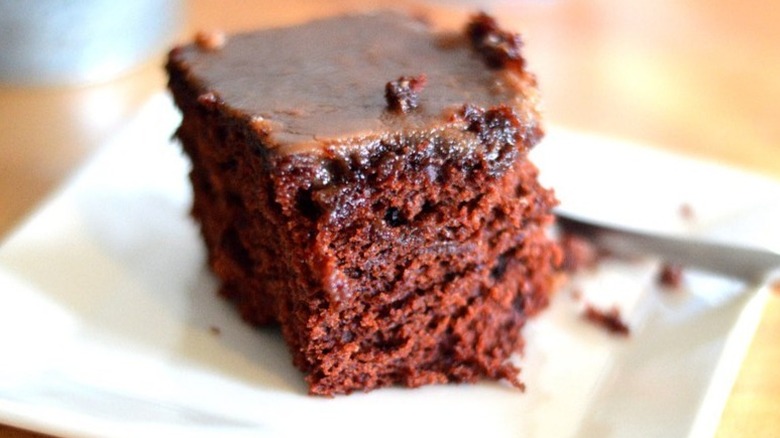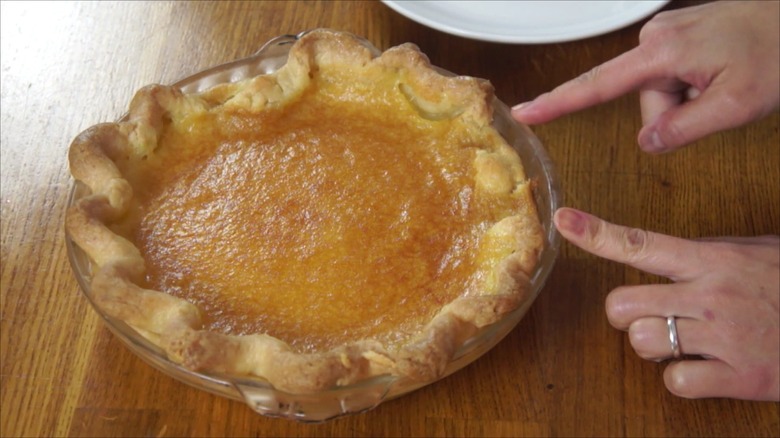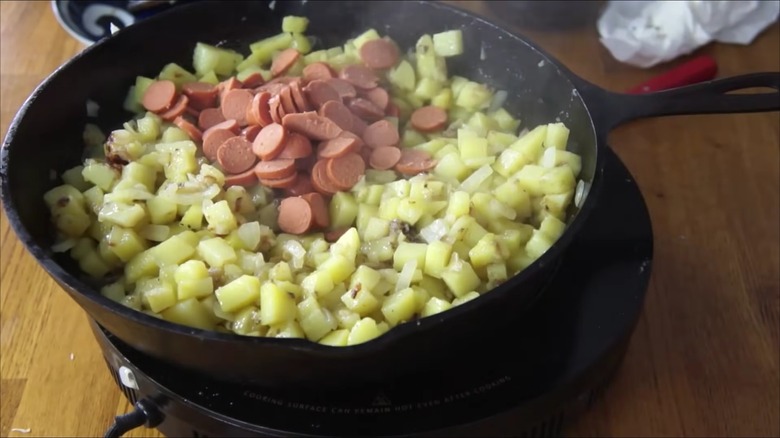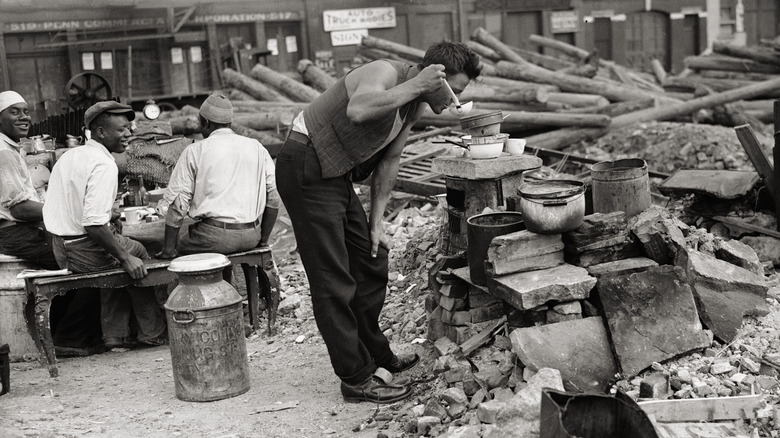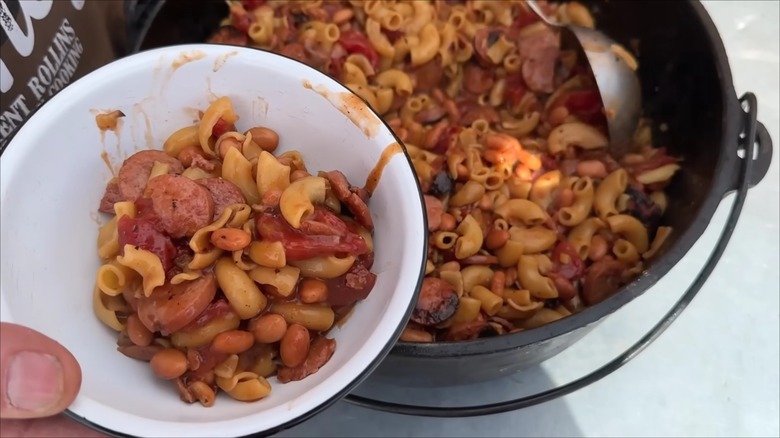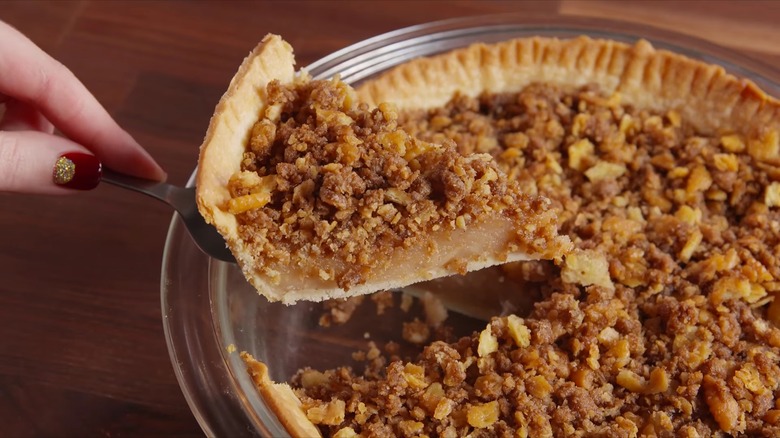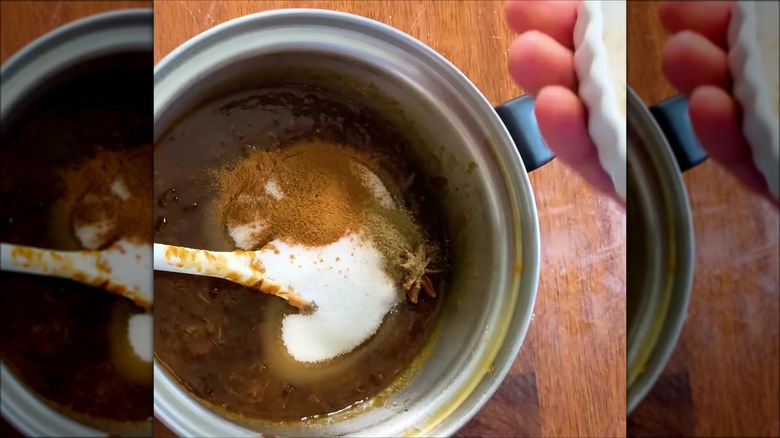17 Foods That Made Their Mark During The Great Depression
The images that come to mind when thinking of the Great Depression are brutal: Absolutely decimated fields, unemployed bankers meandering the streets, and soup kitchen lines linger among other associations. There's not much that can positively be said about the dark spot in U.S. history, but its effect on contemporary American cuisine is becoming harder and harder to deny. On one hand, there were more logistical changes that came as a result of the Great Depression, including the establishment of soup kitchens, a shift in open public policy surrounding food, and the rise of large food brands.
But, beyond the tangible, the Great Depression spelled out a major change for the American food structure. During those lean years, American families faced major food insecurity that not only challenged how they procured food, but also how they could make it last. The Depression meant a shift in American dietary habits that leaned towards the nutritious, sustainable, and indulgent where possible. Despite the hardship, there are many Depression-era foods that endure to this day in American cuisine. Read below to learn more about 17 foods that made their mark during the Great Depression.
1. Buttermilk
Today, buttermilk is a darling of the dairy aisle with its bold flavor, thick texture, and medley of vitamins. But, there was a time when buttermilk was the cheap remaining dairy by-product that floated families during the Great Depression.
Buttermilk was for many a means of survival during the lean years of the Depression. In the '20s it was common to churn butter at home, which produces buttermilk as a natural by-product. During the era of economic and agricultural uncertainty, many families needed to stick to a "waste not, want not" attitude. Even those who did not churn butter at home could still go to local creameries where they could purchase, but more often than not, receive buttermilk for free.
In the kitchen, buttermilk found any number of uses and added flavor, nutrition, and fluffiness to the kitchen in hard times. From being enjoyed as a glass on its own, to making soups, biscuits, and pancakes, buttermilk has remained a staple in American cuisine for its merit and versatility.
2. Cornbread/Johnny Cakes
During the Great Depression, corn meal was one kitchen staple that was typically easily accessible and cost-effective. To utilize this ingredient during hard times, home cooks began making Johnny cakes, a Northeastern bread that became particularly popular during the Great Depression.
Though a bit more obscure than cornbread, Johnny cakes are similar in concept, utilizing corn meal as their base ingredient. They're a bit richer and more decadent than the average cornbread, as well. Some people triangulate Johnny cakes as a sort of thin, fried cornbread-pancake hybrid, and it's no doubt that they provided some sort of comfort and nutrition during harder times. Certainly Johnny cakes just haven't received the notoriety they deserve, and we think even the modern kitchen could benefit from a good venture in Johnny cake-making.
3. Dandelion salad
Dire times call for a bit of creativity, or going back to the roots. In some areas, foraging became a part of eating during the Great Depression, and hand-picked dandelion salad was something that could be found on the dinner table. Dandelions made for a pretty ingenious addition to the diet: Not only do the weeds grow in abundance, but they also have a slightly tangy edge to them similar to spinach.
Clara Cannucciari, a former chef and cookbook author, shared the dandelion salad recipe she ate during the Great Depression in this video. While the extremely tough years of the Great Depression have past, the then 94-year-old chef explored the simple wonders of the salad: It's completely free to make, nutritious, and for some, is wonderfully delicious. In fact, according to Mount Sinai, dandelions are rich in iron, potassium, vitamins A, B, C, and D, minerals, and zinc.
4. Spam
Spam is a sort of legendary food that has found its way into cuisine to both the exuberance and horror of many; there is something about canned meat that just inspires a big reaction. Spam first made it on to the market in 1937, during the Great Depression. The product featured meat that would most likely not sell on its own: a square of pork shoulder and other bits of pork ham, mixed with a sugar, salt, and starch to bind it. The name Spam actually is supposed to be a combination of "spiced and ham."
The simple Spam recipe hasn't changed since its inception, but its popularity has certainly ebbed and flowed. While there was a call for cheap and convenient foods during the Great Depression, there was some hesitancy around Spam, and many were confused as to why the meat didn't need to be refrigerated.
It was when the U.S. entered World War II that the meat really took off as a means to feed the troops, and the mystery meat still remains relatively popular where they were once stationed. Nonetheless, it was the economic circumstances of the Great Depression that brought this pop culture icon to the stage and to the plate.
5. Kraft Macaroni & Cheese
Kraft Macaroni & Cheese is still a cheap eat that many turn to in a pinch and for comfort. The mac launched in 1937 alongside other convenient foods like Spam. At the time, macaroni and cheese casserole was a popular and economic meal to feed families and dinner parties. Kraft provided a quicker and more convenient way to make this comforting dish. With its product, named the Kraft Macaroni Dinner, or just Kraft Dinner for short, a meal could be made 7 to 9 minutes. Part of the reason why the meal could be prepared so quickly is because Kraft had patented an instant cheese powder, which is still a feature in its contemporary recipes.
It seemed that the company struck the right nerve, and in its first year, it sold more than 9 million boxes of the instant macaroni. But, there's a long-lasting genius to this craft, and Kraft remains a recognizable brand.
6. Hearty soups
Soups are filling, comforting, and cheap; in short, they are perfect to fall back on to in hard times. During the Great Depression, many soup recipes began arising out of need, hunger, and creativity. Soups in this era were designed to be as nutritious as possible, and for some families, they were a part of everyday life for dinner. They would often be as loaded as possible: potato, onions, and beans could all be found floating just underneath the surface. Buttermilk would also be added to further thicken up the soup and fill stomachs.
The Great Depression kitchen was not one that would throw away food that could be used, and often this meant that leftovers would get tossed into the soup bowl. While this usually meant leftover meats, some families would take this to new extremes. One journalist recalled her grandmother's "Depression soup," which contained a roving collection of all kitchen scraps in one bowl. Anything from fish heads, to rabbit bones, to bits of rice, and broccoli ends would patchwork themselves into the freezer box's broth. While this may be far from what we can stomach today, as the journalist notes, perhaps there's something to learn from the stick-to-it-ness of the Depression-era soup.
7. Peanut butter
Peanut butter is an ingredient that everyone knows, but it was the Great Depression that really put it on the map, and on the plate. The late '20s saw the rise of major peanut butter brands, some of which still exist to this day, including Skippy and Peter Pan, which were able to produce peanut butter en masse and lower the price on what was once a luxury good reserved for the well-to-do.
During the harder times of the Great Depression, peanut butter was especially important in that it was low in cost and high in calories. These were two critical considerations for many people, and often, peanut butter sandwiches would even be handed out in food lines. Around the same time, soft and cheap white bread had also been developed. The ingredients for the modern American sandwich had been developed just in the nick of time, and would stay much longer as a childhood staple for many Americans to come. People began to create a variety of peanut butter sandwiches including the peanut butter and pickle sandwich, a combination that still has some fans today.
Aside from sandwiches, peanut butter was used as one of the main ingredients when making a no yeast bread. Finally, and perhaps most surprising for us in the 21st century, was a heavily promoted dish known as peanut butter-stuffed onions. As the name suggests, this dish saw onion halves filled with peanut butter. Even after baking, this combination feels somewhat disconcerting.
8. Meatloaf
Meatloaf is something that can still be found on the dinner table. Really, the simple yet enticing meatloaf traces its way back to Ancient Rome, where Romans were documented enjoying the dish with wine and bread. Stateside, meatloaf experienced a resurgence in the 19th century with the invention of the meat grinder.
It was, however, the Great Depression that spelled a major renaissance for the meaty dish, even though meat wasn't served every day. The real goal with meatloaves was to be able to make the pricier meat last longer and be more filling. Home cooks ground the beef and combined it with what was around, including more traditional ingredients like (stale) bread crumbs and seasonings, as well as macaroni, potatoes, and even biscuits. The goal with meatloaf was to load it up as much as possible. While that may not necessarily be the case today, the meal is still a regular for many families.
9. Potato candy
Potato and candy? There are stranger things out there. This food is actually an Appalachian specialty treat that most likely traces back to Central-Eastern Europe. The candy uses potato as a starch for the dough, which some Redditors rightfully point out acts as a sort of marzipan alternative. Despite potato candy's European roots, its peanut butter filling makes it all-American.
During the Great Depression, these candies were almost as low cost as it could get, especially given the cheap cost of peanut butter at the time. Naturally, potatoes have long been a food for hard times, and the '30s were no exception. It is only natural that potato candies would capitalize on available ingredients and provide a little bit of sweetness in harsh times. While the candies have all but faded into obscurity, they still remain well-known, or at least well-loved in Appalachia.
10. Rocky Road ice cream
Rocky road may be one of your favorite orders at the ice cream shop today, but its history began during the Great Depression. In 1929, right at the epicenter of the economic crash, ice cream makers Joseph Edy and William Dreyer of Edy's Ice Cream decided to lean into the absurdity of the time. While tinkering with flavors, they added marshmallows, chocolate chunks, and walnuts to chocolate ice cream — and Rocky Road was born.
The ice cream was made with intention, and was supposed to elicit feelings of joy and perhaps indulgence to those who grabbed a spoon and dug in. There is certainly something poetic in finding something delicious in the rockiest of roads, as evidenced by the ice cream. There has proven to be some longevity in Rocky Road and it can still be found alongside modern ice cream flavors; you can even make your own tub of Rocky Road at home.
11. Surprise cake and Wacky cake
Even in tough times, people seem to find room for dessert. It may be surprising just how they do this, and "surprise cake" best exemplifies this. The cake, which is in essence a spice cake, uses tomato soup in lieu of buttermilk. Hence, the surprise!
Tomato soup really works as an unusually powerful baking alternative, where it provides acidity and acts as a thickening agent not dissimilar to buttermilk. Many assert that the tomato can't be tasted, at least not really. Those who swear by tomato soup in baking praise it for the moistness it lends to the recipe it graces. Surprise cakes actually survived beyond the Great Depression and could even be found in popular culture more or less into the '60s.
Another cake that was popularized during the Great Depression was the so-called "wacky cake." The cake truly made due with what was at hand and is a no-thrills recipe that opts for cheaper alternatives. Instead of butter, the recipe calls for cooking oil, and instead of milk, it uses water; the most expensive items on the list are cocoa powder and sugar.
12. Water pie
It goes without saying that during the Great Depression, all food was scarce. This meant cooks had to find creative ways to use cheap, readily available ingredients to make something edible and, if possible, tasty. Water pie is a prime example of this, boasting a filling that's made, as the name suggests, mostly from water.
When the water is combined with sugar, butter, a little vanilla, and flour, baked and then cooled, it results in a filling with a custard-like consistency. Food writer Harold McGee pointed out to Atlas Obscura that this consistency is due to the combination of flour and water, saying, "If you think about mixing flour or cornstarch and water, the consistency you get will depend on the proportions. So if you're adding a little cornstarch to thicken a stir-fry, you'll end up with something sauce-like, but on the other extreme, Turkish delight is essentially a gel of cornstarch and sugar and nothing else. [Water] pie is essentially in the middle of those two extremes."
The finished pie is not all that bad thanks to an overwhelmingly sweet taste. What's more, it's versatile and can be made richer through the addition of egg yolks while other flavorings can be used in place of the vanilla. One variation even sees the water replaced with Sprite.
13. Poor man's meal
Poor man's meal is a quintessential Great Depression-era food. Featuring onions, hot dogs, and potatoes, it provided exactly what people wanted during this time: A cheap, hearty meal. The dish is made by frying up cubed potatoes with slices of onion, and slices of hot dog. Water is added toward the end of the cooking process, to develop a sauce. Additional seasonings are often incorporated, but poor man's meal is known for being a relatively bland dish due to the large amounts of potato it contains.
Poor man's meal is one of many Depression era dishes that featured hot dogs. These were one of the cheapest sources of protein around at the time and, as a result, were widely eaten. Of course, poor man's meal can be made with any type of sausage or meat, but nearly everyone agrees that true Depression-era versions of the dish use the humble hot dog.
14. Mulligan stew
Stews have fed humans for thousands of years. They're particularly useful in times of economic hardship, as the cooking process softens tough cuts of cheap meat, draws nutrients from otherwise inedible ingredients such as bones, and can easily be altered to make use of whatever ingredients are to hand. An example of one such stew that was popular during the Great Depression is Mulligan stew, a type of Irish stew that combines beef with a variety of odds and ends.
It's thought that Mulligan stew was particularly popular amongst the Depression-era's homeless community, who traveled the country via rail while looking for work. In this setting, several individuals would club together, combining whatever they could to produce a communal meal. Because of this, there's no one recipe for Mulligan stew, although there are a few ingredients that were often seen in the dish including potatoes, tomatoes, and some form of animal protein, usually beef or chicken.
During the Great Depression, it wasn't uncommon for all the ingredients to be added to the pot at once, along with a large volume of water. Modern recipes encourage cooks to brown the meat and vegetables prior to adding the liquid so as to give the dish more flavor, and stock is also preferred over water for the same reason. No matter how it's made, however, Mulligan stew is a filling, cheap, and delicious meal.
15. Hoover Stew
President Herbert Hoover was the man in charge of the United States during the beginning of the Great Depression. His response to the crisis was heavily criticized at the time and, as the president, blame was often heaped upon him. For this reason, shanty towns were named Hoovervilles, newspapers were known as Hoover blankets, and a popular Depression-era stew served at soup kitchens became known as Hoover stew.
The main ingredients of Hoover stew were macaroni, hot dogs. stewed tomatoes, and corn. Like many other dishes in this article, the process of cooking Hoover stew was simple because many people were forced to cook it on the road, above an open fire. To make Hoover stew, all someone had to do was boil the pasta, fry the hotdogs then mix everything together with the stewed tomatoes and corn before simmering and serving. The finished dish was hot, filling, and above all, cheap.
16. Mock apple pie
Despite the United States having an abundance of apple trees, the fruit itself has not always been readily available and cheap. This was the case during the Great Depression. Despite there being a bumper crop of apples in 1929, many Americans were forced to go without these fruit because they were unable to access or afford any. These people were forced to find an alternative filling for their pie and many turned to crackers, Ritz crackers specifically.
Crackers have been used to make a faux apple filling since the mid-19th century. When they're broken up and soaked in water or syrup, with some lemon and spices, they adopt a taste and a texture that's not dissimilar to a regular apple pie filling. The mixture can then be baked inside a normal pie crust, resulting in a dish known as mock apple pie.
Despite not carrying the nutritional benefits of apples, crackers did have the huge benefit of being relatively cheap and non-perishable. As a result of this and the filling's enjoyable flavor, mock apple pie became a popular dessert during the Great Depression and a recipe for the dish was even printed on boxes of Ritz crackers from 1934 until 1993.
17. Prune pudding
Unlike several other fruits during the Great Depression, prunes were relatively cheap. For this reason, prunes were used to make or flavor a variety of dishes, the most famous of these being prune pudding, known at the time as prune whip. This dish was essentially a mixture of boiled prunes, flour, sugar, and spices like cinnamon. The resulting pudding was essentially a sweet and sticky sludge.
Prune pudding is heavily associated with the Great Depression because it was a dish often served at the White House during this time. Thanks to Eleanor Roosevelt, her husband's administration practiced frugal cooking and eating in a mark of solidarity with the rest of the country. In fact, Roosevelt boasted after a lunch three weeks after her husband's inauguration that they'd been fed a two course meal — featuring prune whip — that only cost seven and a half cents per person. Despite her endorsements, prune pudding did not remain popular once the Great Depression was over, and is rarely eaten today.
